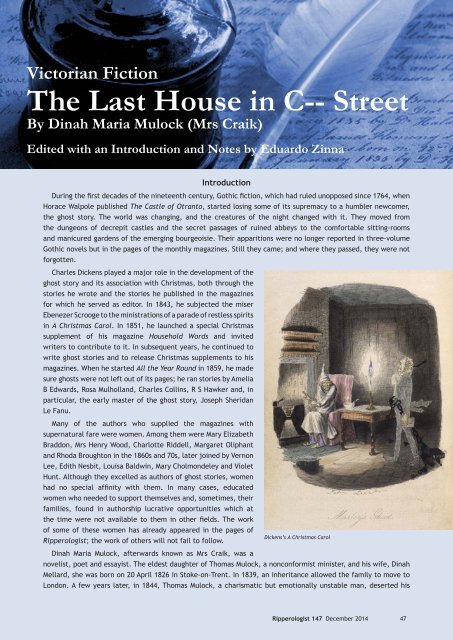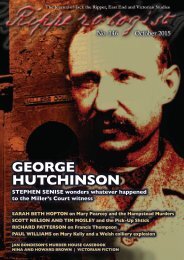Edmund Reid
nuhf574
nuhf574
You also want an ePaper? Increase the reach of your titles
YUMPU automatically turns print PDFs into web optimized ePapers that Google loves.
Victorian Fiction<br />
The Last House in C-- Street<br />
By Dinah Maria Mulock (Mrs Craik)<br />
Edited with an Introduction and Notes by Eduardo Zinna<br />
Introduction<br />
During the first decades of the nineteenth century, Gothic fiction, which had ruled unopposed since 1764, when<br />
Horace Walpole published The Castle of Otranto, started losing some of its supremacy to a humbler newcomer,<br />
the ghost story. The world was changing, and the creatures of the night changed with it. They moved from<br />
the dungeons of decrepit castles and the secret passages of ruined abbeys to the comfortable sitting-rooms<br />
and manicured gardens of the emerging bourgeoisie. Their apparitions were no longer reported in three-volume<br />
Gothic novels but in the pages of the monthly magazines. Still they came; and where they passed, they were not<br />
forgotten.<br />
Charles Dickens played a major role in the development of the<br />
ghost story and its association with Christmas, both through the<br />
stories he wrote and the stories he published in the magazines<br />
for which he served as editor. In 1843, he subjected the miser<br />
Ebenezer Scrooge to the ministrations of a parade of restless spirits<br />
in A Christmas Carol. In 1851, he launched a special Christmas<br />
supplement of his magazine Household Words and invited<br />
writers to contribute to it. In subsequent years, he continued to<br />
write ghost stories and to release Christmas supplements to his<br />
magazines. When he started All the Year Round in 1859, he made<br />
sure ghosts were not left out of its pages; he ran stories by Amelia<br />
B Edwards, Rosa Mulholland, Charles Collins, R S Hawker and, in<br />
particular, the early master of the ghost story, Joseph Sheridan<br />
Le Fanu.<br />
Many of the authors who supplied the magazines with<br />
supernatural fare were women. Among them were Mary Elizabeth<br />
Braddon, Mrs Henry Wood, Charlotte Riddell, Margaret Oliphant<br />
and Rhoda Broughton in the 1860s and 70s, later joined by Vernon<br />
Lee, Edith Nesbit, Louisa Baldwin, Mary Cholmondeley and Violet<br />
Hunt. Although they excelled as authors of ghost stories, women<br />
had no special affinity with them. In many cases, educated<br />
women who needed to support themselves and, sometimes, their<br />
families, found in authorship lucrative opportunities which at<br />
the time were not available to them in other fields. The work<br />
of some of these women has already appeared in the pages of<br />
Ripperologist; the work of others will not fail to follow.<br />
Dickens’s A Christmas Carol<br />
Dinah Maria Mulock, afterwards known as Mrs Craik, was a<br />
novelist, poet and essayist. The eldest daughter of Thomas Mulock, a nonconformist minister, and his wife, Dinah<br />
Mellard, she was born on 20 April 1826 in Stoke-on-Trent. In 1839, an inheritance allowed the family to move to<br />
London. A few years later, in 1844, Thomas Mulock, a charismatic but emotionally unstable man, deserted his<br />
Ripperologist 147 December 2014 47




